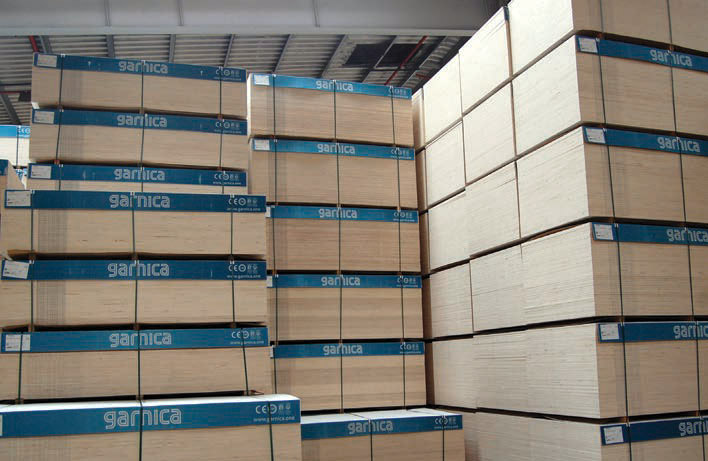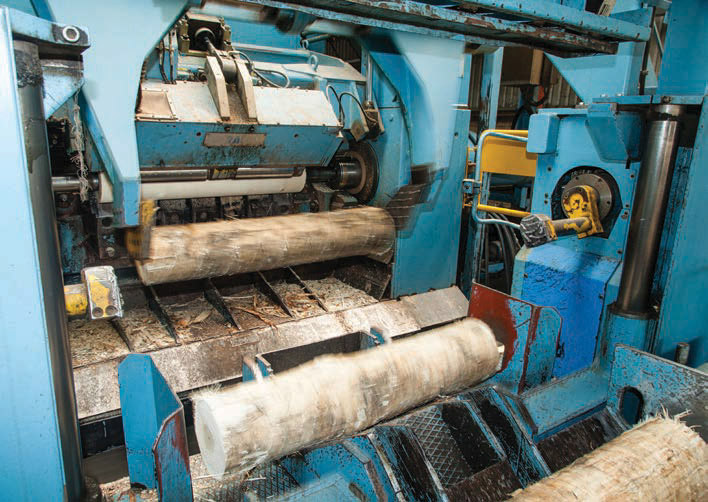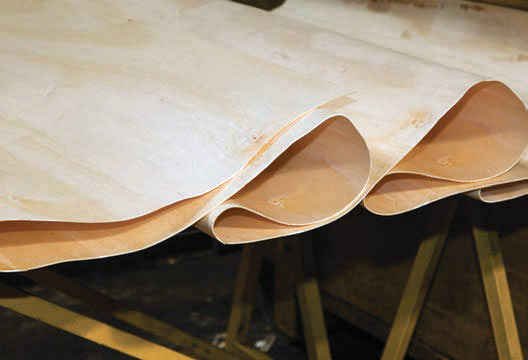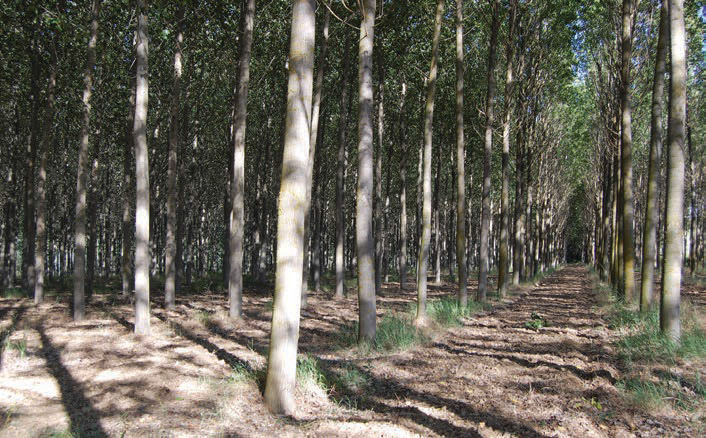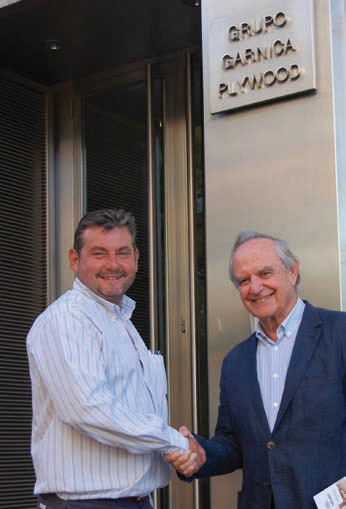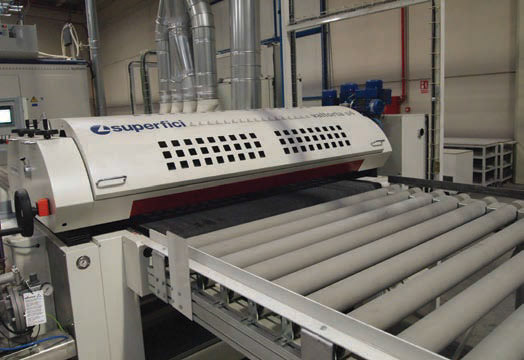The poplar choice
29 December 2017Spanish poplar plywood producer Garnica has an ambitious growth and product innovation programme. Stephen Powney visited its mills in northern Spain
The Rioja region in northern Spain is famed the world over for its wine. Less well known is the fact that it’s an important hub for poplar plywood production in Europe, with family company Garnica Plywood operating three factories in the area.
With so much non-European plywood being imported to the EU, Garnica is arguably bucking the trend by being a European plywood producer with an expansion policy and new product development programme as it fulfils its “Challenge the Ordinary” company motto.
The figures show a group production capacity (five mills) of over 300,000m3 and annual sales of more than €200m to more than 40 countries. About 90% of its products are exported.
An important recent trading development has been the appointment of James Latham as its exclusive UK distributor, stocking poplar plywood products Duraply, Fireshield, Efficiency Poplar and Elegance Birch.
Garnica had already been supplying individual UK manufacturers with large contract orders, but the Lathams partnership allows it to reach a much bigger customer base.
This year Lathams and Garnica have combined to display the product at both the Surface Design Show and Timber Expo, while for the Material of the Modern World – Plywood exhibition at the V&A Museum Lathams supplied 140 Garnica Fireshield and 90 Garnica Elegance Birch sheets.
TTJ was recently given the opportunity to go behind the scenes at Garnica to see its production operations, poplar plantations and learn about its ethos and growth plans for the future. Lathams’ depot director at Thurrock, Miles Kember joined the trade media for the visit.
Garnica’s Panel Making History
Garnica has its origins as a sawmiller in Baños de Río Tobia (La Rioja) in 1941. In 1973 the company founded Maderas Garnica and opened a factory in the town for the production of plywood.
In the 1980s Garnica started to export plywood to several countries, with the material destined for the caravan industry, boats or furniture, among other applications. A new mill in Fuenmayor was brought into operation in 1995, followed a year later by another in Valencia de Don Juan (León).
In 2010, the group invested €30m in enlarging the Baños factory and building a peeling and drying operation in Samazan, southern France, giving the group five factories.
An important landmark came in 2016 when venture capital group ICG became a shareholder in a move to help finance an ambitious growth programme which will see total investment of more than €60m in 2016-2019.
The strategic plan targets a 400,000m3 annual plywood capacity by 2019, which will require a poplar wood consumption of more than 950,000m3. By 2021, Garnica expects to be at least quadruple the size of any of its competitors in European poplar plywood production.
It is the poplar plantations dotted around the region which provide an important and steady stream of raw material – Garnica’s León factory alone consumes about 2,000 trees per day.
The company, which is progressively moving away from tropical timber, is buying about 60% of all poplar trees harvested in Spain and is buying more every year to satisfy production growth.
The climatic conditions, soil quality and easy access to water make the trees grow very quickly. Harvesting takes place at just 15 years and the wood has a density of about 400kg/m3, making poplar plywood lightweight – an advantage for several applications.
The lower branches are trimmed when trees are young in order to reduce defects and improve veneer surface quality. European plantation poplar also gives Garnica a sustainability narrative in its marketing – sustainably-managed material from a known, local source which can provide supply continuity for customers.
Product Range
So, the benefits being communicated by the Garnica-Lathams partnership of this poplar resource used in plywood products can be summarised as advantages in weight (lightweight), high surface quality and visual appearance (an ivory white colour for poplarfaced products), dimensional stability and ease of machining/handling.
Efficiency Poplar panels (6-40mm thicknesses) have a broad range of applications: decorative coverings for walls, ceilings, façades, interior partitions, panelling, plus semi-structural uses in roof panelling, and sandwich panels. The furniture industry and toys, marquetry and the DIY sector are also markets.
Euro Class B-s1-d0-rated Fireshield (6-30mm) differs from some other flame retardant panels in that the treatment process is applied during manufacture to every single veneer so its properties remain intact when working or sanding the panels and it gives a light coloured face without marks, edge degradation or surface salt crusts.
Typical uses are public places, trains, ships, furniture and construction or decorative elements.
Modified and preservative-treated Duraply (10-30mm), which can be finished in a UV coating, HPL, MDO, PRM or XP, is designed for external applications such as construction, signage, façades and street furniture.
Elegance Birch (6-30mm), a poplar core panel covered with decorative birch veneer, is a decorative covering for walls, ceilings, façades, interior partitions and furniture.
The factories producing these products have seen high investment levels.
The Valencia de Don Juan factory in León, north-west Spain, focuses mainly on producing volume entry-level products.
Production technology used includes Angelo Cremona and Raute log peelers for the face and core veneers respectively, with Cremona driers, Ventek GSc2000 grade scanning and further Raute and Cremona equipment taking care of veneer classification, while Biele is a staple for Garnica group factory handling operations.
This integrated factory peels logs, produces plywood and distributes veneers for other Garnica group factories as well. The factory presses a large range of sizes, (including 13.5mm, 16.5mm and 37.5mm specifications for customers wanting to apply an HPL face), with every panel having its full specification and ID printed on the side.
The Raute 24-layer multi-daylight press, installed two years ago, is the largest press of its kind in Europe – so big the factory roof had to be built higher and a pit dug in the factory floor to incorporate the full height. It can press 48 panels at a time.
To the east, in the Rioja region, are Garnica’s three other Spanish mills – two in Baños de Río Tobia and one at Fuenmayor – near the region’s capital Logroño.
The original production site (Baños1) is a “do-it-all” mill with a big range of products, featuring a 15-layer press. Nearby, the Baños2 plant operates a Marzola 24 daylight press and its products include large sized 10- foot Poplar panels.
The Fuenmayor mill, which has a number of presses including a Pagnoni 24-daylight press, has seen recent major investments, including a new building to house new finishing lines and a 5ft wide UV lacquering line as Garnica looks to add more value to production. New SCM Group equipment includes DMC sanding and Superfici Valtorta finishing machines.
The site has also been experimenting with accessing the ultralight and structural insulated panels (SIP) market, using XBS, a foam core product for lightness, insulation qualities and acoustic properties with a large investment in a production line planned for 12-160mm thick panels. The product is billed as being just 30% of the weight of standard OSB SIPs.
Garnica is also excited about digital printing possibilities onto existing veneered surfaces with no paper base and has a small pilot line at Fuenmayor to develop the process. It sees great possibilities for this product in the restaurant/hotel business and plans to invest in an automated line in 2018. An engineered wood floor product line is also planned as an imminent investment.
Duraply modified plywood
One of Garnica’s recent investments was in production of Duraply, its exterior grade plywood featuring modified impregnated veneers for durability and performance. Garnica’s commercial director Alfonso Munoz said demand for the product was so high that a trebling of capacity for the product was introduced over the summer shutdown period.
The product, competing against marine plywood from Asia, is modified to HC3 and warrantied for 15 years against delamination, fungal growth and insect attack.
“We sell it for many applications including building fascias, playground equipment and agricultural buildings,” he said.
“It’s around the same price as marine ply, giving you very high levels of exterior performance and a warranty which you won’t get for marine ply.”
The key element of Garnica’s treatment process is that all veneers are impregnated with timber preservatives and antifungicidals before pressing to avoid problems associated with treating plywood after pressing.
Lathams’ Miles Kember believes Duraply has multiple advantages.
“Poplar trees take 15 years to reach maturity for harvesting and then can be made into Duraply but a tropical marine plywood product often uses 100-year-old trees and has to be shipped halfway around the world,” he said.
“Lathams really thinks the future is moving away from tropical products.”
Lathams has won a contract to supply Network Rail with Duraply 25mm product for platform huts. The product has also been used for some National Trust signage. Garnica pointed to Holland as a market which has strongly accepted Duraply.
“In Holland, Duraply has largely replaced Malaysian/Indonesian marine plywood and we are shipping over 1,000 containers a year to Holland now,” added Mr Munoz.
“The products can also be supplied white primed or have MDO overlay and are commonly used as a barge boards for homeowners as the product does not swell or crack the paint like alternative panels.”
The fire-rated Fireshield product is impregnation treated in a similar way and has the highest Euroclass B fire classification possible for a wood-based panel and, said Mr Kember, is also high on aesthetics.
“The fact that you can veneer or finish the treated surface is a big, big selling point,” he said.
Lathams is very focused on getting the message about Duraply to the end user, the distributor and the consumer. It recently appointed a new employee in the south-east of England to promote the product.
Garnica also reported interest in Duraply and Fireshield from a major UK architect. To help brand and identify the Duraply and Fireshield products, the former will have green pack wrapping and the latter will have red.
Meanwhile, on the Elegance Birch product front, Miles Kember reported a £30K contract win from a client who was previously buying S-grade Russian birch ply as it has the same face veneers but with a poplar core comes in considerably cheaper.
“We will sell a lot of this product into birch plywood customers such as shopfitters and joinery companies in the UK,” he said. In addition, some customers who were buying birch ply are now buying poplar ply and coating it due to the light in colour clear faces.
Customer markets and expansion
Garnica UK customer orders can be seen in the factories, with packs for the likes of Morland, Lambson Building Products and Decorative Panels and Lamination Ltd. Caravan giants like the Swift Group and the Explorer Group are big end users, along with yacht builders Sunseeker and Beneteau, and demand high-quality products.
Garnica hopes its products will also make inroads in the UK merchanting sector and copy its success in Holland.
“At the moment DIY and merchant markets are more focused on Chinese and price point product,” added Mr Munoz.
“We are hoping in time that the UK DIY sheds and merchants will put more emphasis on sustainability and product performance and take the product on in the future.”
Lathams started importing from Garnica in January 2017 and by the summer had bought over £1m of the product, with one individual order for 1,500 sheets of 9mm Fireshield.
“Within three years our plan would be to import 10,000m3 a year of poplar ply,” said Mr Kember. “That could be more than half of Lathams’ hardwood ply product.”
And in that time frame Garnica could well have more factories. As well as increasing production capacity at its newer facilities it is looking to potentially add factories in Spain and France.
